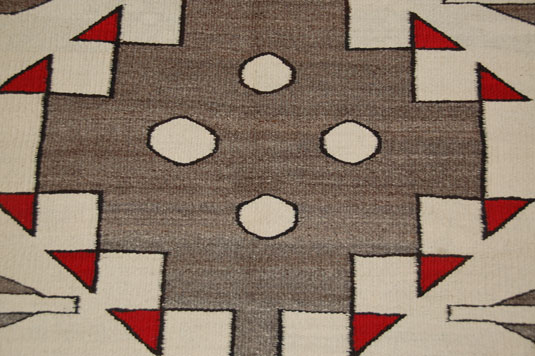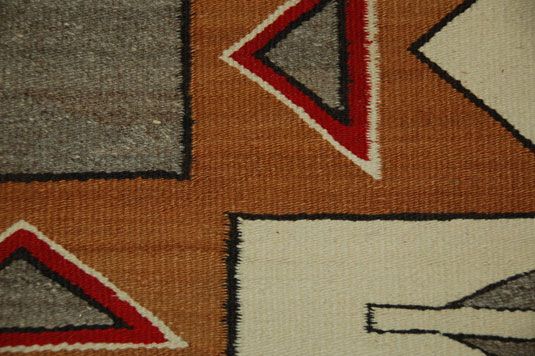Navajo Large Crystal Trading Post Floor Rug [SOLD]
+ Add to my watchlist Forward to Friend
- Category: Navajo Textiles
- Origin: Diné of the Navajo Nation
- Medium: wool
- Size: 56” x 99” (4’8” x 8’3”)
- Item # SC3816E SOLD

The names J. B. Moore and Crystal Trading Post go together like peanut butter and jelly. One rarely says one name without saying the other. Moore had a short tenure at Crystal Trading Post but his legacy lived on for many years. He had arrived there in 1897 and departed in 1911.
Moore determined to improve the quality of wool used in rugs by having it cleaned and dyed under his wife’s supervision. For even better quality, he sent wool to a commercial scouring plant for preparation. Additionally, he strived to have the weavers make rugs that were marketable, rugs based on patterns that potential buyers would associate with their thoughts of how a rug should look.
Navajo weavers were making traditional blankets at that time which were devoid of borders. Moore wanted borders on the weavings so they would look more like rugs rather than blankets. The weavers found it difficult to add a border around all four sides of a weaving. The superstitious women were not comfortable enclosing their designs within a border from which their talent could not escape allowing for another rug to be made later. Whether Moore suggested it or whether the women implemented it by themselves, the weaver’s pathway—a single strand of yarn from the inner part of the rug through the border—was developed. There was precedent for such as all Navajo ceremonial baskets had a break in the bands of design to allow for talent of the weaver to be freed.
Moore, to further refine the marketability of rugs, provided he weaver’s with photos of Persian carpet designs suggesting they model their weavings after those because Easterners were used to Persian rugs in their homes and would more likely purchase Navajo rugs if their look was familiar.
Moore’s influence on the weavers in the Chuska Mountains of northern New Mexico did not die out when he departed in 1911. His influence continued on the weavers until the 1940s.
This floor-size Navajo rug from the 1920s shows some influence from Moore but also shows how patterns began changing after his departure. The wide border persisted, as did individual design elements, but the rugs became simpler in overall appearance. This rug has a large white field on which are centered three large block design elements. The central element is a diamond with four white circles in its interior. It is flanked by a pair of four-pointed stars, each including multi-colored triangles. Floating independently on the field are paired feathers connected at their stems.
This rug is heavy and hugs the floor beautifully. It lies flat on all four corners. It is clean and ready for use as a functional floor rug.
Condition: very good condition
Provenance: from a private collection
Recommended Reading: The Waver’s Pathway—a Clarification of the “Spirit Trail” in Navajo Weaving by Noël Bennett, 1974.

- Category: Navajo Textiles
- Origin: Diné of the Navajo Nation
- Medium: wool
- Size: 56” x 99” (4’8” x 8’3”)
- Item # SC3816E SOLD



